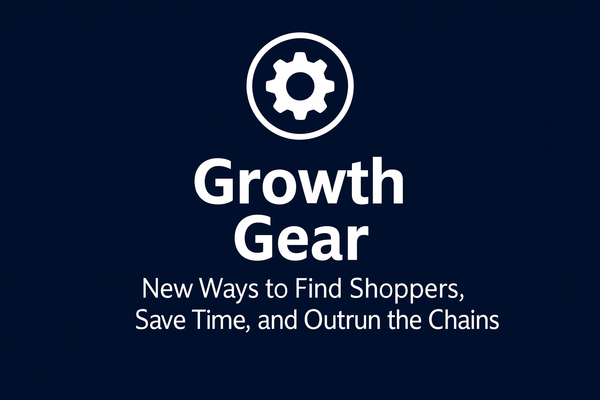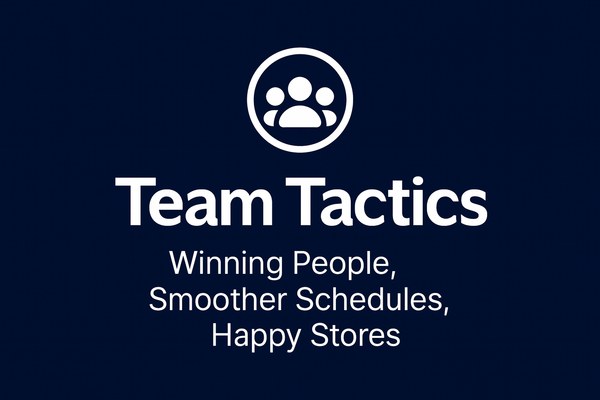Creating a Memorable First Impression
Customers form judgments within seven seconds of visual contact with your store. Research shows 95% consider exterior appearance critical, while optimized entrances report 15-25% higher conversion rates and 12-18% increases in average transaction values through strategic design.

The moment a customer approaches your convenience store, you have approximately seven seconds to make a lasting impression that determines whether they'll enter, browse, and ultimately purchase—or simply drive past to your competitor down the street. For independent operators competing against chain stores with corporate design budgets, creating an impactful entrance strategy becomes not just important, but essential for survival and growth.
Research from the retail psychology field reveals that 95% of customers consider exterior appearance a critical factor in their shopping decisions, while 80% will try a new store if the exterior appears clean and inviting. More significantly, stores with optimized entrance strategies report 15-25% higher conversion rates from foot traffic to actual purchases, and 12-18% increases in average transaction values as positive first impressions carry through the entire shopping experience.
Independent convenience store owners possess a unique advantage in entrance design: the ability to create authentic, community-focused experiences that reflect local character and personal values—something chain competitors cannot replicate with their standardized corporate approaches. When executed strategically, entrance design becomes a powerful competitive differentiator that builds customer loyalty, drives repeat visits, and creates the foundation for sustainable business growth.
The Psychology of First Impressions in Retail
The Seven-Second Decision Window
Customers form their initial judgment about your store within seven seconds of visual contact—before they've even reached the door. This rapid assessment process, rooted in evolutionary psychology, evaluates safety, quality, value proposition, and personal relevance almost instantaneously. Understanding this timeline is crucial for independent operators who must maximize every element within that critical window.
The psychological evaluation process unfolds in predictable stages:
Initial Approach (0-2 seconds): Visual scan for basic safety, cleanliness, and operational status
Brand Assessment (2-4 seconds): Evaluation of professional appearance, brand consistency, and quality indicators
Value Determination (4-6 seconds): Assessment of whether the store meets immediate needs and preferences
Entry Decision (6-7 seconds): Final commitment to enter or continue past the location
The Decompression Zone Concept
Upon entering any retail space, customers require a psychological transition period known as the decompression zone—typically the first 10-15 feet inside the entrance. During this critical period, customers adjust from the external environment to your store's atmosphere, allowing their minds to shift from travel mode to shopping mode.
Effective decompression zones serve multiple psychological functions:
- Stress reduction by providing breathing room between outside chaos and shopping focus
- Sensory adjustment allowing eyes to adapt to different lighting and brain to process new environment
- Orientation establishment helping customers understand store layout and navigation options
- Expectation setting creating initial perceptions about product quality, service level, and overall experience
Failed decompression zones—cluttered with merchandise, promotional signage, or obstacles—overwhelm customers before they can properly engage with your store, often resulting in quick exits or distracted, hurried shopping experiences that reduce transaction values.
The Power Wall Advantage
Retail psychology research consistently demonstrates that 90% of customers naturally turn right upon entering a store—a phenomenon known as "the invariant right". This predictable behavior creates what retailers call the "power wall": the right-hand wall area that receives the highest customer attention and offers maximum merchandising impact.
Strategic power wall utilization can dramatically influence customer behavior:
- Product placement in this zone receives 3-4 times more visual attention than other areas
- Promotional displays positioned here achieve 25-30% higher engagement rates
- Seasonal merchandising gains maximum exposure and turnover velocity
- High-margin items benefit from premium positioning without additional advertising costs
The Five-Element Entrance Strategy Framework
Element 1: Exterior Magnetism and Curb Appeal
Your store's exterior serves as a billboard, advertisement, and invitation rolled into one powerful marketing tool that must function effectively 24 hours a day. Unlike chain stores constrained by corporate design standards, independent operators can create distinctive exteriors that reflect community character while optimizing customer attraction.
Signage Strategy for Maximum Impact:
text
PRIMARY SIGNAGE REQUIREMENTS
Visibility: Readable from 300+ feet at highway speeds
Brand Recognition: Consistent colors, fonts, and messaging
Information Hierarchy: Store name, key offerings, hours prominently displayed
Lighting Integration: Illuminated signage extending operational hours
SECONDARY SIGNAGE OPPORTUNITIES
Directional Wayfinding: Clear entrance and parking indicators
Promotional Announcements: Fuel prices, special offers, new products
Community Integration: Local sponsorships, community event announcements
Safety Communication: Security features, emergency information
Exterior Design Elements That Drive Traffic:
text
LIGHTING AS CUSTOMER MAGNET
Safety Perception: Well-lit parking and entrance areas signal security
Product Visibility: Interior lighting showcasing merchandise through windows
Brand Presence: Illuminated signage maintaining visibility after dark
Atmosphere Creation: Warm lighting temperatures (3000K-3500K) creating welcoming ambiance
LANDSCAPE AND MAINTENANCE SIGNALS
Professional Appearance: Maintained landscaping suggesting operational excellence
Seasonal Adaptation: Changing displays reflecting current relevance and freshness
Cleanliness Standards: Immaculate exterior surfaces, windows, and parking areas
Community Pride: Local touches demonstrating neighborhood commitment
Element 2: Window Merchandising and Transparency
Your store windows function as your most valuable advertising space—free, highly visible, and operating continuously to attract customers and communicate value proposition. Strategic window merchandising transforms casual passersby into motivated shoppers while reinforcing brand messaging and current promotions.
Effective Window Display Strategy:
text
VISUAL MERCHANDISING PRINCIPLES
Eye-Level Focus: Primary products positioned at average customer eye level (5'6" height)
Three-Point Rule: Limit focal points to three or fewer to avoid visual overwhelm
Color Psychology: Use warm colors (reds, oranges) for urgency, cool colors (blues) for trust
Lighting Drama: Strategic illumination creating depth, highlighting products, eliminating shadows
CONTENT ROTATION AND RELEVANCE
Seasonal Updates: Monthly display changes reflecting current weather, holidays, events
Community Connection: Local themes, school colors, community event tie-ins
Product Education: Clear pricing, benefit communication, usage suggestions
Promotional Emphasis: Limited-time offers, new products, exclusive local items
Window Display Categories That Convert:
text
IMPULSE ATTRACTION DISPLAYS
Convenience Essentials: Beverages, snacks, personal care items prominently featured
Weather-Responsive: Umbrellas during rain season, sunscreen for summer, hot coffee in winter
Emergency Preparedness: Batteries, flashlights, basic supplies during storm seasons
LOCAL MARKET ADAPTATION
Community Events: School spirit items, local team merchandise, event supplies
Cultural Relevance: Products reflecting neighborhood demographics and preferences
Seasonal Celebrations: Holiday-specific items, local festival merchandise
Economic Sensitivity: Value offerings, bulk options, promotional pricing clearly displayed
Element 3: Entrance Flow and Accessibility Design
The physical design of your entrance must accommodate the widest possible customer base while creating intuitive traffic flow that guides shoppers naturally through your merchandising strategy. Effective entrance design removes barriers—both physical and psychological—that might prevent customers from entering or shopping comfortably.
Universal Accessibility Considerations:
text
PHYSICAL ACCESSIBILITY STANDARDS
Door Width: Minimum 36" clear opening accommodating wheelchairs and mobility devices
Threshold Design: Level or minimal transition preventing tripping hazards
Handle Height: ADA-compliant positioning accessible to seated and standing customers
Surface Materials: Non-slip flooring preventing weather-related safety issues
FAMILY-FRIENDLY ACCOMMODATIONS
Child Safety: Automatic door sensors preventing accidents, rounded corner fixtures
Stroller Navigation: Wide aisles and doorways accommodating family shopping needs
Parent Convenience: Clear sightlines allowing supervision while shopping
Multi-generational Access: Visual and physical accessibility for elderly customers
Traffic Flow Optimization:
text
NATURAL MOVEMENT PATTERNS
Right-Turn Preference: Entrance positioning encouraging natural rightward movement
Clear Sightlines: Unobstructed views of store layout from entrance position
Navigation Cues: Flooring materials, lighting changes, or subtle barriers guiding movement
Bottleneck Prevention: Adequate space preventing crowding during peak periods
DECOMPRESSION ZONE DESIGN
Spatial Requirements: 10-15 feet of uncluttered space inside entrance
Sensory Transition: Flooring change, lighting adjustment, or temperature modification
Orientation Aids: Clear signage or layout visibility helping customers understand options
Welcome Messaging: Subtle branding or greeting elements creating positive initial experience
Element 4: Atmospheric Design and Sensory Experience
Creating the right atmosphere within your entrance area involves orchestrating multiple sensory experiences—visual, auditory, and olfactory—that work together to create positive emotional responses and encourage extended shopping sessions.
Multi-Sensory Entrance Strategy:
text
VISUAL ATMOSPHERE ELEMENTS
Color Psychology: Warm, inviting color schemes creating comfort and encouraging lingering
Lighting Levels: Balanced illumination preventing glare while showcasing merchandise effectively
Visual Organization: Clean, uncluttered presentation suggesting quality and professionalism
Seasonal Adaptation: Periodic updates maintaining freshness and current relevance
AUDITORY ENVIRONMENT DESIGN
Background Music: Low-volume, demographically appropriate selections enhancing mood
Operational Sounds: Properly functioning equipment suggesting reliability and quality
Noise Management: Sound absorption materials reducing harsh echoes or mechanical noise
Communication Systems: Clear, professional audio for announcements or emergency communications
SCENT AND AIR QUALITY MANAGEMENT
Fresh Coffee Aromatics: Coffee station positioning allowing natural scent marketing
Cleanliness Indicators: Fresh, neutral scents suggesting sanitary conditions and quality
Ventilation Effectiveness: Proper air circulation preventing stuffiness or odor concentration
Food Service Integration: Strategic positioning of food preparation areas for positive scent marketing
Element 5: Staff Presence and Customer Service Integration
The human element of your entrance strategy—how customers are greeted, acknowledged, and initially served—often determines whether positive first impressions translate into completed transactions and return visits.
Service Excellence at the Entrance:
text
GREETING STRATEGIES FOR IMPACT
Timing: Acknowledgment within 10 seconds of customer entry
Authenticity: Genuine, personalized greetings rather than scripted responses
Cultural Adaptation: Greeting styles matching community expectations and demographics
Consistency: Standardized friendliness across all shifts and staff members
ASSISTANCE AND GUIDANCE SYSTEMS
Proactive Help: Staff positioned to offer directions or product location assistance
Problem Resolution: Immediate response to entrance-related issues or customer concerns
Product Knowledge: Staff capability to answer questions about featured entrance displays
Community Connection: Employees able to discuss local events, preferences, and needs
Implementation Strategy: Building Your Entrance Advantage
Phase 1: Current State Assessment and Opportunity Identification
Before investing in entrance improvements, conduct a comprehensive analysis of your current entrance performance and customer response patterns. This assessment provides the foundation for targeted improvements that deliver maximum return on investment.
Entrance Performance Audit Process:
text
CUSTOMER BEHAVIOR OBSERVATION
Entry Conversion Rate: Percentage of approaching customers who actually enter store
Dwell Time Analysis: Time customers spend in entrance area before beginning shopping
Navigation Patterns: Routes customers naturally follow after entering store
Peak Period Challenges: Congestion points or accessibility issues during busy times
PHYSICAL CONDITION ASSESSMENT
Maintenance Issues: Lighting problems, cleanliness concerns, signage visibility
Safety Hazards: Trip hazards, door malfunctions, inadequate lighting
Accessibility Barriers: Physical obstacles preventing full customer access
Seasonal Challenges: Weather-related problems affecting entrance functionality
COMPETITIVE COMPARISON ANALYSIS
Local Market Standards: How your entrance compares to nearby competitors
Industry Benchmarks: Professional standards for convenience store entrance design
Unique Opportunities: Potential differentiators unavailable to chain competitors
Customer Expectation Alignment: Whether current entrance meets community standards
Phase 2: Strategic Design Development and Budget Planning
Effective entrance improvements require balancing maximum customer impact with realistic budget constraints and operational requirements. Independent operators must prioritize improvements that deliver measurable results while maintaining day-to-day operational effectiveness.
Budget-Conscious Improvement Prioritization:
text
HIGH-IMPACT, LOW-COST IMPROVEMENTS (Under $2,000)
Deep Cleaning and Maintenance: Professional exterior washing, window cleaning, minor repairs
Lighting Upgrades: LED conversion, improved bulb placement, timer installation
Signage Refresh: Updated pricing displays, promotional signage, directional indicators
Entrance Merchandising: Strategic product positioning, impulse item placement
MODERATE INVESTMENT IMPROVEMENTS ($2,000-$10,000)
Window Display Systems: Professional merchandising fixtures, lighting, seasonal displays
Entrance Flooring: Non-slip materials, cleanliness-enhancing surfaces, brand integration
Security Enhancements: Camera systems, improved lighting, safety feature installation
Accessibility Upgrades: Door automation, ramp installation, threshold modification
MAJOR RENOVATION PROJECTS ($10,000+)
Complete Entrance Redesign: Architectural modifications, expansion, major reconstruction
Branding Integration: Comprehensive signage system, color scheme implementation
Technology Integration: Digital displays, smart lighting systems, customer analytics
Landscape Architecture: Professional landscaping, parking improvements, exterior enhancement
Phase 3: Implementation Timeline and Change Management
Successful entrance improvements require careful timing and coordination to minimize operational disruption while maximizing customer impact during the transition period.
Implementation Best Practices:
text
PRE-IMPLEMENTATION PREPARATION
Customer Communication: Advance notice of improvements, temporary inconvenience explanations
Staff Training: Employee preparation for new systems, customer questions, operational changes
Vendor Coordination: Detailed scheduling preventing conflicts between multiple improvement projects
Permit Requirements: Necessary approvals for signage, electrical, structural modifications
PHASED IMPLEMENTATION STRATEGY
Week 1-2: Maintenance and cleaning improvements with immediate visibility impact
Week 3-4: Lighting and signage upgrades enhancing customer attraction
Week 5-6: Merchandising and display improvements optimizing sales conversion
Week 7-8: Fine-tuning and adjustment based on customer feedback and performance data
POST-IMPLEMENTATION OPTIMIZATION
Performance Monitoring: Customer behavior changes, conversion rate improvements, sales impact
Feedback Collection: Customer and staff input on improvement effectiveness
Continuous Refinement: Ongoing adjustments based on seasonal changes and performance data
ROI Documentation: Measurable results justifying investment and planning future improvements
Measuring Success: Entrance Strategy Performance Indicators
Quantitative Performance Metrics
Effective entrance strategies produce measurable improvements in customer behavior and business performance that justify the investment while providing guidance for future enhancements.
Key Performance Indicators for Entrance Effectiveness:
text
CUSTOMER CONVERSION METRICS
Foot Traffic Conversion: Percentage increase in customers entering after improvements
Average Transaction Value: Impact on per-customer spending following entrance enhancements
Visit Duration: Time customers spend in store correlated with entrance experience quality
Return Visit Frequency: Customer loyalty improvements attributable to positive first impressions
OPERATIONAL EFFICIENCY INDICATORS
Staff Productivity: Reduced time spent on entrance-related customer service issues
Maintenance Requirements: Decreased upkeep needs through improved material selection
Safety Incidents: Reduction in entrance-related accidents or security concerns
Seasonal Performance: Entrance effectiveness across different weather and lighting conditions
Qualitative Assessment Methods
Beyond numerical metrics, entrance success requires ongoing evaluation of customer satisfaction, community perception, and competitive positioning relative to market expectations.
Customer Experience Evaluation Process:
text
DIRECT CUSTOMER FEEDBACK COLLECTION
Entry Experience Surveys: Brief questionnaires about first impressions and entrance experience
Focus Group Sessions: Community input on entrance effectiveness and improvement suggestions
Mystery Shopper Evaluations: Professional assessment of entrance impact on shopping decisions
Online Review Monitoring: Customer comments about store appearance and accessibility
COMMUNITY REPUTATION ASSESSMENT
Local Business Network Feedback: Input from other business owners about community perception
Community Leader Input: Feedback from civic leaders, government representatives
Social Media Monitoring: Online discussion about store appearance and community standing
Word-of-Mouth Tracking: Employee and customer reports about community conversation
Advanced Strategies for Competitive Differentiation
Technology Integration for Modern Appeal
Contemporary customers expect convenience stores to embrace technology that enhances their experience while maintaining the personal touch that distinguishes independent operators from chain competitors.
Technology Enhancement Opportunities:
text
DIGITAL DISPLAY SYSTEMS
Dynamic Pricing Displays: Real-time fuel price updates, promotional pricing changes
Community Information Boards: Local event calendars, weather updates, traffic information
Product Information Systems: QR codes linking to detailed product information, nutritional data
Interactive Elements: Touch screens for loyalty program signup, community feedback collection
SMART LIGHTING AND SECURITY SYSTEMS
Motion-Activated Lighting: Energy-efficient systems providing safety while reducing operational costs
Smart Security Integration: Camera systems with mobile monitoring, emergency alert capabilities
Automated Door Systems: Hands-free entry improving accessibility and perceived modernity
Environmental Controls: Automated heating, cooling, and ventilation optimizing customer comfort
Seasonal Adaptation and Community Integration
Independent stores excel when they demonstrate deep community connection and responsiveness to local needs, seasons, and cultural events.
Community-Centric Entrance Strategies:
text
SEASONAL COMMUNITY ENGAGEMENT
Local School Support: Team colors, championship celebrations, graduation recognition
Cultural Festival Integration: Community event themes, ethnic celebration acknowledgment
Weather Response Planning: Storm preparation displays, seasonal comfort items prominence
Agricultural Calendar Awareness: Harvest season themes, farming community needs recognition
LOCAL PARTNERSHIP INTEGRATION
Community Business Collaboration: Cross-promotional displays, local product features
Municipal Government Cooperation: Public safety campaigns, community information distribution
Non-Profit Organization Support: Charity drive collection points, awareness campaign participation
Local Artist Collaboration: Community artwork display, local talent showcase opportunities
Accessibility Excellence and Inclusive Design
Creating truly welcoming entrances requires going beyond basic ADA compliance to embrace universal design principles that serve the broadest possible customer base.
Inclusive Design Implementation:
text
COMPREHENSIVE ACCESSIBILITY FEATURES
Multi-Language Signage: Community demographic reflection in entrance communication
Sensory Accommodation: Visual contrast enhancement, audio cues for vision-impaired customers
Cognitive Accessibility: Clear navigation, simple signage, logical layout presentation
Economic Accessibility: Value option visibility, affordable product prominence
FAMILY AND ELDERLY CUSTOMER OPTIMIZATION
Multi-Generational Comfort: Seating areas, rest opportunities, social interaction spaces
Child Safety Features: Rounded corners, secure displays, supervised sightlines
Elderly Customer Support: Adequate lighting, clear signage, comfortable navigation
Caregiver Convenience: Space for assistive devices, accessible product placement
Crisis Management and Entrance Recovery Strategies
Weather and Environmental Challenge Response
Convenience stores must maintain attractive, functional entrances despite weather extremes, seasonal challenges, and environmental factors that can quickly undermine customer attraction efforts.
Environmental Resilience Planning:
text
WEATHER-PROOFING STRATEGIES
Storm Damage Recovery: Rapid restoration procedures, emergency signage, safety communication
Snow and Ice Management: Heated walkways, salt application, emergency traction materials
Extreme Heat Response: Shade structures, cooling system visibility, comfort product prominence
Flood and Water Damage: Drainage systems, elevated displays, water-resistant materials
SEASONAL TRANSITION MANAGEMENT
Spring Preparation: Deep cleaning, landscape restoration, fresh promotional themes
Summer Optimization: Cooling system showcase, outdoor comfort items, travel supply prominence
Fall Adaptation: Seasonal color integration, comfort food emphasis, weather preparation displays
Winter Readiness: Heating demonstration, emergency supplies, warm beverage prominence
Security and Safety Incident Recovery
When security incidents or safety concerns affect customer perception of your entrance, rapid and comprehensive response is essential for maintaining community trust and customer comfort.
Security Recovery Implementation:
text
INCIDENT RESPONSE PROTOCOLS
Immediate Safety Restoration: Professional security assessment, visible safety improvements
Community Communication: Transparent information sharing, safety measure explanation
Enhanced Security Integration: Improved lighting, camera upgrades, staff training
Long-term Trust Rebuilding: Consistent safety demonstration, community engagement
PREVENTIVE SECURITY ENHANCEMENT
Crime Prevention Through Environmental Design: Natural surveillance, territorial reinforcement
Customer Safety Education: Emergency procedures, safety feature communication
Staff Security Training: Threat recognition, de-escalation techniques, emergency response
Community Cooperation: Local law enforcement partnership, neighborhood watch coordination
Future-Proofing Your Entrance Strategy
Emerging Customer Expectations and Market Trends
Successful independent operators anticipate changing customer expectations while maintaining the authentic community connection that differentiates them from chain competitors.
Trend Adaptation Planning:
text
SUSTAINABILITY INTEGRATION
Environmental Responsibility Demonstration: Solar lighting, recycling programs, sustainable materials
Energy Efficiency Showcase: LED lighting prominence, smart system integration, cost-saving demonstration
Community Environmental Leadership: Local environmental initiative support, green business certification
HEALTH AND WELLNESS EMPHASIS
Cleanliness Prominence: Sanitization stations, cleanliness certification, health safety communication
Wellness Product Integration: Healthy option prominence, nutritional information availability
Community Health Support: Health screening events, wellness program partnerships
Technology Evolution and Digital Integration
As customer expectations continue evolving toward digital integration, entrance strategies must balance technological advancement with the personal touch that independent stores provide.
Digital Evolution Strategy:
text
PROGRESSIVE TECHNOLOGY ADOPTION
Mobile Integration: QR code systems, app-based loyalty programs, digital payment prominence
Smart Store Features: Inventory tracking visibility, personalized recommendation systems
Community Digital Presence: Social media integration, local news feeds, community event promotion
Data Analytics Integration: Customer behavior tracking, preference analysis, personalized service
Conclusion: Your Entrance as Competitive Weapon
Creating a memorable first impression through strategic entrance design represents one of the most powerful competitive advantages available to independent convenience store operators. Unlike chain stores constrained by corporate standardization, independent operators can create authentic, community-focused entrances that reflect local character while optimizing customer attraction and conversion.
The five-element framework—exterior magnetism, window merchandising, entrance flow, atmospheric design, and staff integration—provides a systematic approach to entrance optimization that delivers measurable results. When implemented strategically, entrance improvements typically produce 15-25% increases in customer conversion rates and 12-18% improvements in average transaction values within the first six months.
Success requires treating your entrance as an integrated system rather than a collection of separate elements. Signage, lighting, merchandising, accessibility, and staff training must work together to create a cohesive experience that guides customers naturally from initial approach through completed transactions. This systems approach ensures that entrance investments deliver sustained competitive advantage rather than temporary aesthetic improvements.
The most successful entrance strategies demonstrate authentic community connection while maintaining professional standards that build customer trust and confidence. Independent operators who master this balance create sustainable competitive advantages that chain stores cannot replicate through corporate policies or standardized designs.
Implementation should proceed systematically, beginning with thorough assessment of current performance and customer behavior patterns, followed by strategic planning that balances maximum impact with realistic budget constraints. Phased implementation allows for continuous refinement based on customer feedback and performance data while minimizing operational disruption.
Remember that your entrance strategy must evolve continuously to maintain competitive advantage and customer interest. Regular assessment, seasonal adaptation, and community responsiveness ensure that entrance investments continue delivering returns while strengthening your position as the preferred local convenience store choice.
Ready to transform your store entrance into a customer magnet? Begin by conducting a comprehensive assessment of your current entrance performance, then develop a systematic improvement plan that reflects your community's unique character while optimizing customer attraction and conversion. Your entrance is your most valuable marketing tool—make every second of that crucial first impression count.





